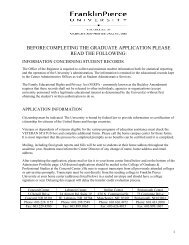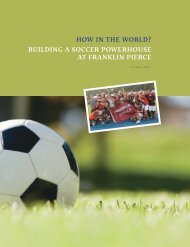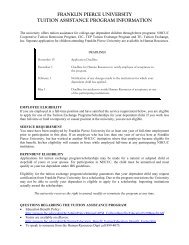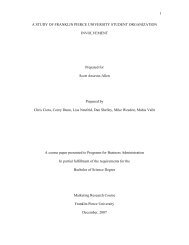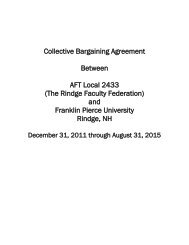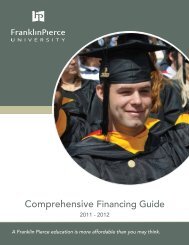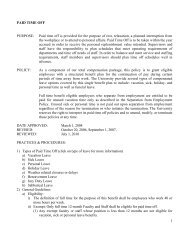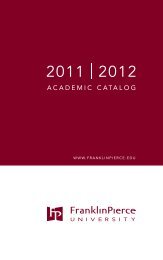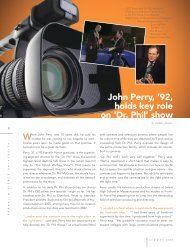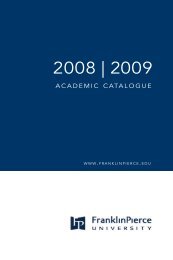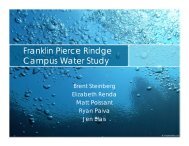THE MAGAZINE OF FRANKLIN PIERCE UNIVERSITY spring 2013
THE MAGAZINE OF FRANKLIN PIERCE UNIVERSITY spring 2013
THE MAGAZINE OF FRANKLIN PIERCE UNIVERSITY spring 2013
Create successful ePaper yourself
Turn your PDF publications into a flip-book with our unique Google optimized e-Paper software.
uniquely Franklin PierceThe Franklin Pierce environmental science programbegan in 1989 with a major in Environmental Sciencedesigned by Dr. Paul Kotila, who had been hired asassociate professor of biology in 1988. While FranklinPierce was relatively late to the environmental curricularmovement, Dr. Kotila saw the program as “ideally suitedto the liberal arts college [as Franklin Pierce was then]and its traditions of interdisciplinary . . . education.” Themajor also sought to capitalize on Franklin Pierce’s rurallocation, easy access to diverse natural habitats on its1,000-acre campus (forests, wetlands, lakes, and streams),and other distinctive campus characteristics, including itsown water supply, sewage treatment facility, and forestmanagement plan.Based in the Natural Sciences Division, the curriculumwas initially built largely from existing courses in otherdepartments (Biology, Chemistry, Sociology, Economics),formulated into a set of courses for breadth (theEnvironmental Science core and electives), and depth(an area of emphasis; Biology/Ecology, Anthropology,Economics). While the particular course offeringshave diversified considerably since its inception,the basic three-part format of the major remains tothis day.The program has evolved significantly since its creationwith the addition of new faculty (Dr. Catherine OwenKoning, Dr. Rhine Singleton), the creation of newcourses specifically designed for the EnvironmentalScience major (Environmental Impact Assessment,Wetlands and Forest Ecology), and a Universitywidecommitment to sustainability as reflected bythe President's Commitment to Climate NeutralityStatement and the hiring of a sustainability coordinator in2010. The addition of the Monadnock Institute of Nature,Place & Culture in 1996 added interdisciplinary depth andcommunity outreach opportunities to the environmentalprogram.ShiFting groundSince the 1970s, broader public awareness of environmentalissues has led to significant improvements in airand water quality and a reduction in certain environmentalabuses. Problems that were relatively easy to identifyand control (e.g., sewage outflows) have given way tomore dispersed and difficult hazards (e.g., non-pointpollutants such as fertilizers and toxins). In addition, thefocus has expanded to global-scale problems, reflectingboth progress in control of “local” challenges as well asrecognition of the interconnectedness of environment,economy, and society. These shifts are evident in highereducation as well. According to a 2012 Princeton Reviewstudy of nearly 7,500 college applicants, 7 out of 10students use information about a school's environmentalcommitment in their decision to apply or attend.When Franklin Pierce joined the list of now over 650signatories to the American College & UniversityPresidents’ Climate Commitment (ACUPCC) in 2007,the University pledged to eliminate net greenhousegas emissions and accepted responsibility to meet theglobal climate challenge. To this end, Franklin Piercesubmitted its first Climate Action Plan in 2010 and willcomplete its third greenhouse gas inventory in <strong>2013</strong>.The University’s commitment is also reflected in the workof the Sustainability Council, which is responsible forthe coordination of institution-wide initiatives and theincorporation of sustainability objectives into the latestStrategic Plan.Results of the Council’s work are evident throughout thecampus: wood pellet boilers for freshman residencesand Northfields Activity Center, the replacement ofincandescent bulbs with fluorescent and LED lighting,new purchasing policies for energy efficient appliances,and the recent switch to single-stream recycling, whichmakes recycling easier and more cost-effective. Itscommitment to reducing greenhouse gas emissions alsomeans educating the University in the interrelated natureof local, regional, and global systems.Franklin Pierce is also an institutional member of theAssociation for the Advancement of Sustainability inHigher Education (AASHE), the leading organizationfor sustainability in higher education. Franklin Pierce’sSustainability Coordinator, Jess Gerrior, together withSustainability Certificate student Corey Hogan ’12,represented Franklin Pierce at the annual AASHEConference in October 2012. Jess’s presentation,www.franklinpierce.edu 5



